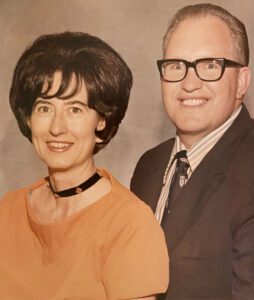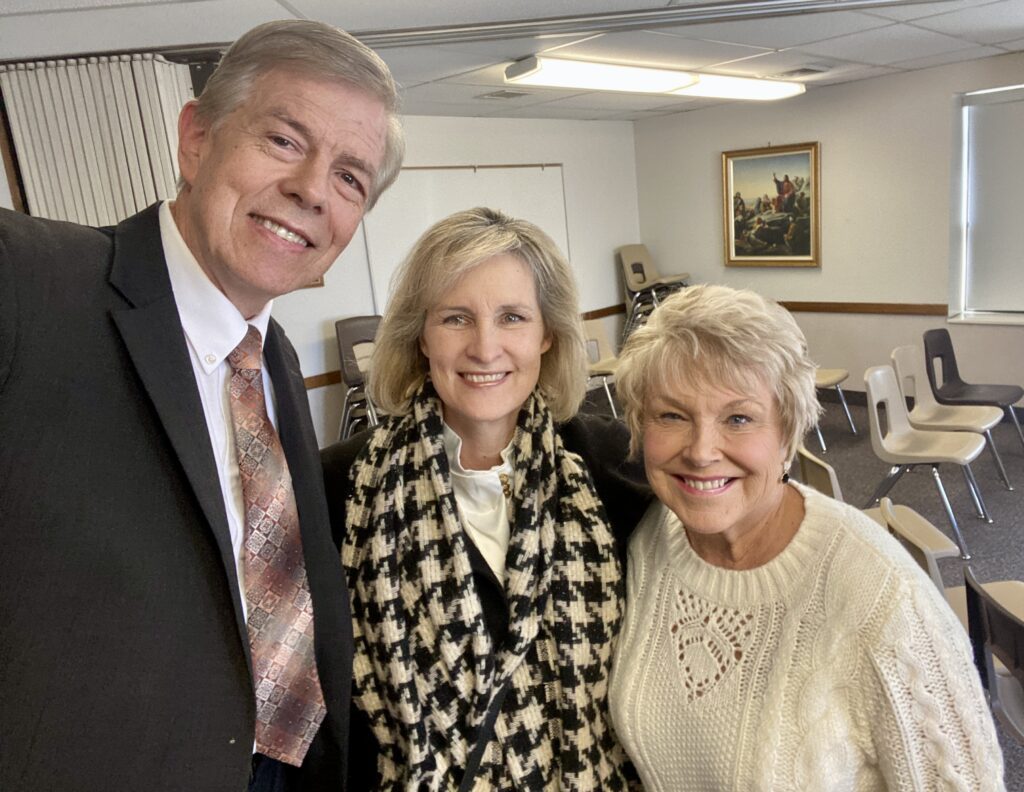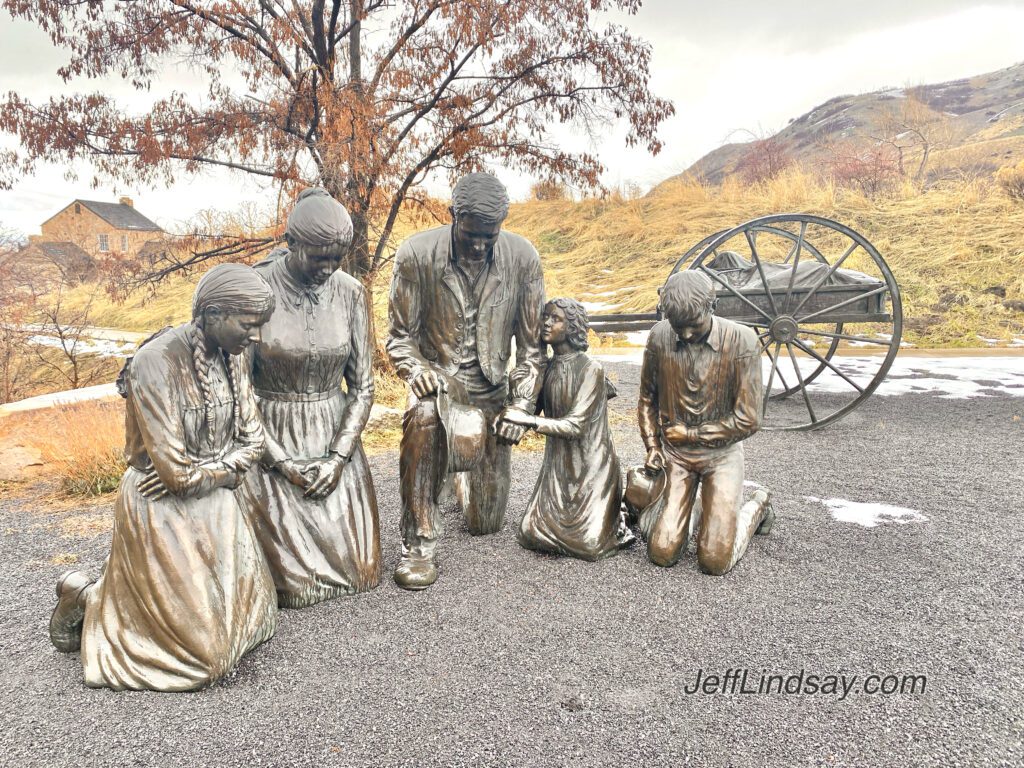
My mother, Mary Lyon Miles Lindsay, passed away a few days ago at the age of 91 years. Many blessings, even small miracles, made it possible for my wife and I to have quality time with her right before the end and to be there with her in her home when she passed away. One of these blessings led me to be present a few days later when a wonderful poet read a poem she wrote long ago that beautifully fits my mother’s long journey of faith. Hearing that poem and meeting the poet was a tender mercy giving me much-needed help in preparing for my remarks at Mother’s upcoming funeral. What follows is an account of some of the events and answers to prayer that gave me choice opportunities to be with her as she approached her journey’s end.
In early December my wife and I sensed that we needed to get back to Utah to visit my aging mother and assist in some of the caregiving, but when? We had many needs and duties involving grandchildren, church, community, and work, so it wasn’t clear when we should leave Wisconsin. We knelt together one Sunday night and asked the Lord to help us know when we should go, and I specifically asked Him to “nudge us,” if possible, to help make the right time clear. That nudging came two days later at a Christmas party for a local community group at the home of a faithful Christian couple. As I sat down to relax and talk, I received a text from a wonderful client of mine, a very sharp CEO, asking if they could send me to attend the Consumer Electronics Shows (CES 2024) from Jan. 9 to 12 in Las Vegas. This gargantuan trade show is one I have long wanted to see, so I was thrilled to have a company sending me there on their behalf to assist in technology scouting and competitive intelligence. One great thing about attending a trade show in Las Vegas is that it is close to Utah. We were able to take an inexpensive flight to Salt Lake after the show and spend a few meaningful days with my mother in her home. This was such a blessing.
A few days after returning to Appleton, Wisconsin, my sister Rosalie told me that my mother was having a serious setback in her health, right as most of her caregivers were all calling in sick and unable to help. I booked a ticket back to Salt Lake to help my sister, who lives in my mother’s home and, with her husband, Ed, has been tirelessly managing care for Mom, sacrificing so much to make her life comfortable and happy. After arriving, I learned that COVID was the problem, and everyone seemed to have it except my mother (her husband did not, but he was away in Brazil helping his own mother). I wasn’t worried because of my “iron-clad” immune system. I had been exposed to COVID extensively in the past few weeks without getting ill. But two days later, after an exhausting night shift and then a day-shift with little chance for rest, I started feeling really exhausted and had a runny nose, some aches, and then chills. Just due to lack of sleep, I hoped. But when I checked my temperature, it was 100.7. Fever. Could it be COVID? Probably. Oh no.
As a precaution, my sister had me go sleep and stay away from Mom while she took the night shift — in spite of being more exhausted than I was. But I agreed to sleep. I also took zinc, vitamin D3, glucosamine, N-acetyl cysteine and the first of several doses of a Nobel-prize winning anti-infectant (i.e., its developer received the Nobel prize) that is on the WHO’s list of essential medicines for humans. It’s a remarkably safe medicine that one influential misinformation source in the US denounced as a “horse dewormer” unfit for human use, when in fact it is approved for human use in the US and many millions of humans around the planet have used it to treat a variety of illnesses, including those caused by parasites as well as viruses. (I really don’t know if it works for most people against COVID, but it has been used with remarkable success by some doctors as part of a protocol for early treatment, and both times I had COVID, I took it and was back to normal in under 3 days). I slept soundly and hoped to be healthy soon.
Unfortunately, when I arose in the morning and checked my fever, it was 104 degrees. Not good. I let me wife know, and she immediately enlisted the faith and prayers of family living nearby. (The faith of my wife, a son, a daughter-in-law and several grandchildren may have given me an unfair advantage.) Then I received a call from my worried daughter-in-law telling me that 104 degrees meant danger and that I needed to get professional care. I explained that maybe I had measured my temperature incorrectly with the forehead thermometer I used, so I tried it again. This time the reading was 101.9 degrees, much better — but still ill. Twenty minutes later I tried again and this time the reading was 98.6. Normal! And that’s how I felt. From that moment on, I did not feel ill. No chills, no sneezing, no fever, no runny nose, just a little sinus congestion left over. The night before I had all the same symptoms as when I had COVID before, but now I felt entirely COVID free even faster than before. And since I appeared to be asymptomatic, I got back to helping my mother and was grateful to be able to spend that time with her. Whatever the cause, this rapid recovery was a small miracle that allowed me to serve again. But Mom was declining. After being there a week, I returned home, glad to have helped. At the time, a hospice worker guessed that Mom might have two months left. Based on her track record of great resilience, I guessed it might be three to six months.
A few days later, my sister sent me a text saying Mom’s decline was even steeper now and that she was refusing food and water. She had rebounded quickly from seemingly serious setbacks in recent months, so we were uncertain about what to do. In spite of many frightening moments in recent year, she really seemed unstoppable — I sometimes speculated that she might outlive all of us. We were supposed to be going on a fabulous trip to Hawaii in a few days where kind friends we met in China had invited us to come stay with them. This would be our first time to Hawaii and we had much to look forward to there. But perhaps it really was urgent that we go back to see her. So my wife and I prayed individually about what to do, and I was surprised that we both felt the same thing: go back to Salt Lake on Tuesday, the next day. This was not the kind of answer to prayer where the voice of the natural man is most easily heard, giving me approval to do what I already wanted to do. This was a difficult answer that meant disruption and sacrifice, or so we thought. But it would mean blessing upon blessing in the end.
I got on the computer that Monday morning to order tickets for Tuesday, but found that there were simply no seats on any flights out of Appleton that could get us to Salt Lake, not even on first class (which we never splurge for). The best I could do was very expensive flights on Wednesday (about $3,000 total for the two of us). I booked those and thought I had done my best. However, something wasn’t right. If we had been inspired to go Tuesday, if that really was the Lord urging us to go Tuesday, then there must be some way. Should we drive? It takes over 20 hours of driving to reach Salt Lake. Could that possibly work? But then a new thought came: maybe we could just drive to a different city whose airport might have Tuesday flights that could lead us back to Salt Lake. With that thought, I quickly found that Green Bay, about 40 minutes away, had flights that could work. It was messy: Green Bay to Chicago, then Dallas, and then Salt Lake, taking the whole day, but we would get to my mother on Tuesday night, not Wednesday. And surprisingly, the Tuesday tickets cost about half the price of the Wednesday tickets, which we were able to cancel for a complete refund.
We arrived at my mother’s house around 10 PM on Tuesday, Feb. 6. She had been sedated to ease whatever had been causing her constant pain and anxiety the day before, but she was still somewhat responsive. She was able to open her eyes a couple of times. We said many things, held her hands, played her favorite song, Hymn no. 34, “O Ye Mountains High,” and generally had meaningful time with her that night until about 1 AM, when we slept a little. We could sleep because Alyssa, a great young lady that we had met in China and had recommended to my sister as a potential caregiver, who had become the cornerstone of Mom’s caregiving staff and was now a dear friend of Mary’s, had finally recovered from her COVID and came to help shortly after our arrival. We went back into Mom’s room at 4:30 AM and learned from Alyssa and Rosalie that Mom’s oxygen level was dropping. Her time was approaching.
We would be joined by other family members later that morning, It was a privilege for us to be in her room at her side as she peacefully passed away, surrounded by loved ones, just a few minutes before 1 PM on Wednesday, Feb. 7. Had we flown on Wednesday, we would have arrived over five hours after her death and probably after her body would have already been taken to the mortuary. A deeply meaningful opportunity would have been missed. How fortunate we were. How blessed we were to be there at her journey’s end.
The following Sunday, two days ago, my wife felt inspired that we should attend my brother David’s ward in Sandy where he serves as bishop. During the second hour, in Priesthood meeting, we had a lesson on faith. I wasn’t paying strict attention, with many things on my mind, until the teacher, Brother Christensen, announced that he had felt inspired to ask his wife to come in and read a poem she had written years ago on faith. I love poetry, so I perked up and paid attention, though my expectations were not high based on the poetry that I have often heard over the pulpit. But this poem was different. This eloquent women immediately piqued my interest with the first few lines — this was real poetry, skillful poetry, and then stirring poetry. I marveled at the imagery as she described the last day of travel of a handcart company about to reach the Salt Lake Valley. When she spoke of those Saints preparing for one last stretch of their journey, washing necks and arms with bits of soap they had saved from the old country for this very day, of men beating their hats until motes of dust danced in the light of the sun as it pulled itself over Little Mountain, as they had done the day before, and of girls putting on white aprons they had washed the night before and left out to dry in moonlight, my heart was leaping for joy. This was poetry that spoke to my soul.
By the end of the poem, I felt like I had learned a dozen lessons on faith and patience. I felt as if a fresh chapter of lost scripture had been found and translated live before me. Who was this woman who had just taught the best Priesthood lesson I had ever heard? I couldn’t let her just quietly go back to her seat in the back of the room. As she tried to do that, I stopped her in her tracks with my questions, asking her to tell us again who she was and how she wrote this poem with such detail and power and had she published more such poetry? I explained that I was asking because this was not an ordinary poem, but a marvelous work! Then she humbly explained that she was Elaine W. Christensen, and that yes, she had published a few books of poetry, and that the Church had asked her to write a poem for the dedication of the “Journey’s End Memorial,” a bronze sculpture at “This Is the Place” Heritage Park depicting a family kneeling in the sand beside their handcart when they reached the Salt Lake Valley, grateful to have reached their journey’s end. The poem, “At Journey’s End.” was published in the July 2002 Ensign and is available online and the Gospel Library app via this link: https://www.churchofjesuschrist.org/study/ensign/2002/07/at-journeys-end?lang=eng.
Elaine W. Christensen — I should have recognized her name when she was introduced. I’ve read some of her poetry before, but I have not paid enough attention to her work. After the lesson, I brought my wife over to meet her and was kindly given permission to share her poem here, along with a photo of my wife and me with her.
This poem spoke so deeply to me as I’ve been pondering my mother’s long journey and the joy she must have now at her journey’s end, with my father at her side, both about to begin a new and more joyous journey. I hope its lessons on faith and perseverance might touch some of you.
At Journey’s End
“The redeemed of the Lord shall return, and come with singing unto Zion” (Isa. 51:11).
For the last time our captain blows the 5:00 A.M. whistle.
For the last time we roll our bedclothes
damp with dew,
to stow them and our five-man tent
in the two-wheeled cart that’s become our home.
The Dutch oven filled with last night’s coals
hangs still warm beneath the oaken bed,
and one last time
we hear the call to circle up for prayer,
a rousing song, and the day’s instructions.
Twelve miles, that’s all that’s left to go.
We wash our faces in the numbing creek,
scrub our sunburned arms and necks with pieces of soap
saved from the old country for this very day.
The men take time to shave
and beat their hats till dust motes dance
in the early sun pulling itself up over Little Mountain,
the one we climbed yesterday.
The girls braid their hair, slick with sugar water,
then tie clean aprons around their waists,
washed last evening and left to dry in moonlight.
Many walked the trail barefoot, the Olsen girls,
young Jimmy Jensen, yet today
they put on their holey shoes
for maybe we’ll shake Brother Brigham’s hand,
drink well water
and slake our thirst at last
with fruit and a glimpse of that salt sea
that’s ebbed and flowed,
one more step, just one more step,
ahead of us, day after day,
like some desert mirage.
Shadows along Emigration Creek,
lined with rough and rangy cottonwoods,
point out the last stretch of road to Zion.
Every morning the shadows have shown us the way.
Today, at journey’s end,
we’ll hear the Nauvoo band play
and we’ll walk, one last time
with our hand-worn friend,
the streets we’ve sung about so many nights
camped on strangely named river banks—
the Platte, Loup Fork, Wood River,
where Sister Sorensen hid herself among the willows
and gave birth to a baby girl.
Thirteen times we crossed the Platte.
Indians carried us on their backs,
while the men ferried our goods across
and floated the emptied carts.
How we pled for the waters to part.
Now we kneel here in the sand, grateful
for every unanswered plea
that proved us.
Faith is the mountain that does not flee,
the water that does not part,
the rock that won’t turn into bread—
instead, marks our dead.
They walk the desert with us today.
Our faith and theirs, wrung drop by drop, blossoms—
red as the promised rose.
For the last time we lift the prop stick
from beneath the cart’s handle.
For the last time we grease the wheels with tallow
and take our accustomed spots, right and left,
front and back,
to push and pull for the very last time,
all that we own,
all that we are,
all that we’ve become
on our wooden cross of a handcart.
We’re tempted to let it have its way at the end,
to hurtle down the hill, an unbridled horse
heading for home.
Yet happy to hold it back one last time
on its steep descent to the valley,
we sing,
our hearts in our mouths,
our hopes before us.
Oh, how we sing
every last one of the songs,
the mighty Redeemer’s songs
that led us to Zion.
Here is the selfie we took with the remarkable poet, Elaine W. Christensen, who helped teach a powerful Priesthood lesson in my brother’s ward. What a privilege to learn from her. Guess whose poem I’m planning to discuss in my remarks at my mother’s funeral this Saturday?

My favorite part of the poem may be in the middle, after the waters to be crossed did not part in spite of so many pleas, yet they still reached the end of their journey, and then they knelt “grateful for every unanswered plea that proved us.” Profound. I especially love a part that Elaine added after the poem seemed finished, but somehow needed something more. She prayed for help to properly complete it, resulting in adding lines to declare the lessons of faith: “Faith is the mountain that does not flee, the water that does not part, the rock that won’t turn into bread—instead, marks our dead.” That echoes in my soul, over and over. Those were words that seemed so perfectly designed for me at this time. But I love so much about this poem, such as the ebb and flow of the salt sea before them each day like a mirage, or having their way pointed by the shadows (not necessarily the light). But I especially like the lines that immediately turn my thoughts to my newly deceased mother: there will soon be a stone to mark her death, and though I may not see or sense her, she will be there, figuratively if not literally at times, as I walk through my own desert seeking Zion, joining my faith with hers, hoping that the result will be blossoms at last, red as the promised rose.
My mother was a remarkable woman. So many of the things that I really like about my life are a result of her influence and teachings, from my love of reading to my interest in science, foreign countries and language, politics, and history to my skepticism of official narratives pushed by highly acclaimed but corrupt men or organizations. Some of my odd humor and unusual tastes in food also can be attributed her, and my love of story-telling. She also strongly encouraged me to pursue the wonderful young lady who is now my wife, probably the most significant part of my life. That all-important pursuit came with her blessing, with no encouragement needed. But it was great to have Kendra be so quickly welcomed into the family and so thoroughly cherished.
Further, it was only today that I finally realized that my interest in defending the Gospel and especially the Book of Mormon came from her influence, from her old books, and from some of the reports she gave me about fascinating insights regarding the Book of Mormon. Her attitude of taking the scriptures seriously and digging in to learn and understand more, an attitude that I share, likely came from the man that influenced her so strongly in matters of faith, her grandfather, George Edmond Miles. The passing of my mother has drawn my heart more fully to my fathers and mothers and the influence they have had across the decades. How grateful I am for their faith and their legacy, but especially for those most direct influences on my, my father and mother.
I was blessed with a mother who was a fiercely independent, non-conformist woman who found the joy that the Gospel brings to both men and women when we allow the Lord to guide us and bless us. Each day since her passing, I’ve discovered more and more about her that has blessed my life in ways I didn’t appreciate before. Her faults, real or imagined, were often easily seen, especially when I was a teenager rapidly approaching omniscience, but it’s her strengths that have made all the difference, and her unshakeable faith and loving service for others stand out as key defining features of her life.
For a brief overview of my mother, please see the brief obituary that will appear in the Deseret News on Friday. Also see the more complete obituary of Mary Lyon Miles Lindsay posted at the Serenity Funeral Home website.
Meanwhile, I marvel at how deeply one poem written well and beautifully read touched me. After that Priesthood meeting, I read it aloud in the car as my wife and I sat in the quiet parking lot after nearly everyone else had left (Sister Christensen was so kind to talk for us for quite a while about the research that went into the poem and other details). I consider myself a calm, controlled person, but I could not get through it without tears. After that practice, I read it again later that day to my sister-in-law, and still had difficulty with surging emotion. I read it aloud again later that day when we visited my father’s sister in an assisted care facility in Ogden in a joyous meeting with her and her daughter, a dear cousin, and again could not get through it without my voice breaking up, so powerful was the poem to me. I hope I can be more calm when I employ that poem in some way in my remarks at the funeral. Wish me luck! I hope this poem will be of value to some of you, just as I hope the life and example of my courageous mother might somehow be of help to others.
Postscript:
I read the entire poem with some commentary in my remarks at the funeral. I noted how my mother’s journey had parallels to the journey Sister Christensen described so beautifully. I talked about its lessons of faith and the need to recognize that there may be purpose and wisdom behind the unanswered pleas that prove us.
A day before the Feb. 17 funeral, my wife and I went to “This Is the Place” Heritage Park in Emigration Canyon and looked at the beautiful sculpture, “Journey’s End.” Here’s a photo:











Jeff,
Thank you for sharing such personal and meaning comments. And, thank you for sharing this beautiful poem and relating it to your mother. She was a wonderful person.
Beautiful message. Beautiful letter. Beautiful poem. It says so much about a great mother and the remarkable man she raised.
Thank you for sharing these tender experiences. The Lord was with you–guiding you, inspiring you, and loving you along the journey that many of us have faced–that of losing a mother. May God continue to bless you with peace and comfort.